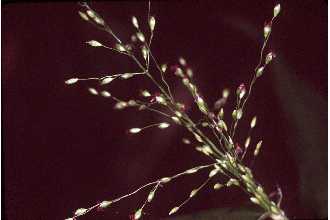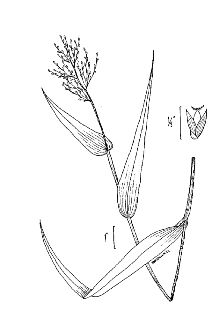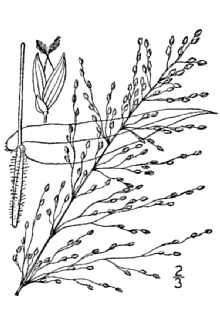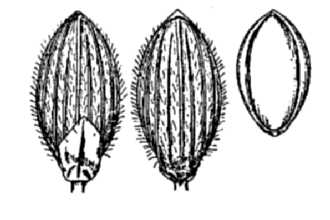Deertongue
Scientific Name: Dichanthelium clandestinum (L.) Gould

| General Information | |
|---|---|
| Usda Symbol | DICL |
| Group | Monocot |
| Life Cycle | Perennial |
| Growth Habits | Graminoid |
| Native Locations | DICL |
Plant Guide
Use soil moisture sensors to measure the soil moisture of Deertongue.
Fact Sheet
Uses
The major use of deertongue is for revegetating disturbed areas where site conditions limit the use of other species. It is tolerant of sites with: (1) a pH as low as 3.8, (2) aluminum concentration which limits growth of other species, and (3) light textured soil which is droughty and infertile. These tolerances allow deertongue to excel when revegetating acid coal and other surface mine spoils, and sandy infertile disturbed areas.
Status
Please consult the PLANTS Web site and your State Department of Natural Resources for this plant’s current status (e, Use soil moisture sensors to measure the soil moisture of Deertongue.,g, threatened or endangered species, state noxious status, and wetland indicator values),
Description
Deertongue is a perennial, warm season grass native to the Eastern United States and Southeastern Canada. The midsummer growth normally reaches a height of one to three feet. The leaf sheath and stem are hairy. Leaves are one-half to one and one-quarter inches wide and four to eight inches long. In autumn culms form a very leafy rosette, four to six inches in height. Deertongue produces short, strong rhizomes. Two seed crops are produced annually: an early crop on an open terminal panicle and a later crop in a panicle enclosed in the swollen leaf sheath. The second crop, produced in the enclosed panicle, produces an abundance of seed. Deertongue has about 400,000 seeds per pound. Deertongue lodges over winter and forms a mat of vegetative cover. Some of the stems break off and are carried away by wind or water. Much of the seed is retained in the leaf sheaths of the old stems.
Adaptation and Distribution
Distribution
Distribution
The natural distribution is Nova Scotia, Quebec, and Maine to Kansas, south to northern Florida and Texas. Deertongue is widely scattered throughout this area volunteering onto denuded sites. It grows well on non-cultivated soil. Because of its tolerance to low pH, high concentrations of aluminum, and droughty infertile conditions, it is commonly found to volunteer on such sites. For a current distribution map, please consult the Plant Profile page for this species on the PLANTS Website. Robert H. Mohlenbrock USDA NRCS 1989 Midwestern Wetland Flora @USDA NRCS PLANTS
Establishment
The type of sites where deertongue is recommended and its seed dormancy characteristics influence the method and timing of establishment. Deertongue should be seeded as early as possible in the spring. Seed dormancy is easily overcome when deertongue is planted during cool weather, so that natural stratification in the soil will occur. If the site conditions restrict early spring planting, it is advisable to sow seed in the late fall or early winter, while dormant. On sites where conventional farm equipment can operate, prepare seedbed as normal for a pasture planting. Use a grain or grass drill; do not place seed deeper than one inch. In sand and gravel pits, the method of choice is to broadcast, then 'track' the seed with lime and fertilizer in with a bulldozer. Hydroseed steep or rough areas, but expect this method to result in less success than those outlined above. Expect slow establishment of seedings. Mulching is beneficial for seedling establishment and erosion control, except in sand and gravel pits. Two tons of straw or hay tacked down is the most desirable method. Where this is not possible, wood fiber mulch should be used at 1,500 pounds per acre. Deertongue is most often planted in mixtures with other warm season grasses such as switchgrass with the total rate of 12-15 pounds per acre. Typically, deertongue does not exceed 3 pounds of the per-acre mix.
Plant Traits
Growth Requirements
| CaCO3 Tolerance | Low |
|---|---|
| Frost Free Days, Minimum | 135 |
| Frost Free Days, Minimum | 130 |
| Fire Tolerance | High |
| Fire Tolerance | High |
| Fertility Requirement | Low |
| Fertility Requirement | Low |
| Drought Tolerance | High |
| Drought Tolerance | High |
| Cold Stratification Required | Yes |
| Cold Stratification Required | Yes |
| Temperature, Minimum (°F) | -33 |
| CaCO3 Tolerance | Low |
| Anaerobic Tolerance | Medium |
| Anaerobic Tolerance | Low |
| Adapted to Medium Textured Soils | Yes |
| Adapted to Medium Textured Soils | Yes |
| Adapted to Fine Textured Soils | Yes |
| Adapted to Fine Textured Soils | Yes |
| Adapted to Coarse Textured Soils | Yes |
| Adapted to Coarse Textured Soils | Yes |
| Hedge Tolerance | None |
| Temperature, Minimum (°F) | -33 |
| Shade Tolerance | Intolerant |
| Shade Tolerance | Intermediate |
| Salinity Tolerance | Low |
| Salinity Tolerance | Low |
| Root Depth, Minimum (inches) | 16 |
| Root Depth, Minimum (inches) | 16 |
| Precipitation, Minimum | 32 |
| Precipitation, Minimum | 32 |
| Precipitation, Maximum | 65 |
| Precipitation, Maximum | 65 |
| pH, Minimum | 4.0 |
| pH, Minimum | 4.0 |
| pH, Maximum | 7.5 |
| pH, Maximum | 7.5 |
| Moisture Use | Low |
| Moisture Use | Low |
| Hedge Tolerance | None |
Morphology/Physiology
| Active Growth Period | Spring and Summer |
|---|---|
| Toxicity | None |
| Toxicity | None |
| Shape and Orientation | Semi-Erect |
| Shape and Orientation | Erect |
| Fall Conspicuous | No |
| Foliage Porosity Winter | Porous |
| Foliage Porosity Winter | Porous |
| Foliage Porosity Summer | Dense |
| Foliage Porosity Summer | Dense |
| Foliage Color | Green |
| Foliage Color | Green |
| Flower Conspicuous | No |
| Flower Conspicuous | No |
| Fire Resistant | No |
| Fire Resistant | No |
| Fall Conspicuous | No |
| Resprout Ability | No |
| Coppice Potential | No |
| Coppice Potential | No |
| C:N Ratio | Medium |
| C:N Ratio | Medium |
| Bloat | None |
| Bloat | None |
| After Harvest Regrowth Rate | Slow |
| After Harvest Regrowth Rate | Slow |
| Active Growth Period | Spring and Summer |
| Resprout Ability | No |
| Foliage Texture | Medium |
| Nitrogen Fixation | None |
| Nitrogen Fixation | None |
| Low Growing Grass | No |
| Low Growing Grass | No |
| Lifespan | Long |
| Lifespan | Long |
| Leaf Retention | No |
| Leaf Retention | No |
| Known Allelopath | No |
| Known Allelopath | No |
| Height, Mature (feet) | 2.0 |
| Height, Mature (feet) | 2.0 |
| Foliage Texture | Medium |
| Fruit/Seed Color | Brown |
| Fruit/Seed Color | Brown |
| Fruit/Seed Conspicuous | No |
| Fruit/Seed Conspicuous | No |
| Growth Form | Bunch |
| Growth Form | Bunch |
| Growth Rate | Moderate |
| Growth Rate | Slow |
Reproduction
| Propagated by Cuttings | No |
|---|---|
| Propagated by Seed | Yes |
| Propagated by Seed | Yes |
| Propagated by Sod | No |
| Propagated by Sod | No |
| Propagated by Sprigs | No |
| Propagated by Sprigs | No |
| Propagated by Tubers | No |
| Propagated by Tubers | No |
| Fruit/Seed Persistence | Yes |
| Seed per Pound | 280000 |
| Seed per Pound | 350000 |
| Seed Spread Rate | Slow |
| Seed Spread Rate | Slow |
| Seedling Vigor | Low |
| Seedling Vigor | Low |
| Small Grain | No |
| Small Grain | No |
| Vegetative Spread Rate | None |
| Vegetative Spread Rate | None |
| Propagated by Corm | No |
| Propagated by Cuttings | No |
| Bloom Period | Early Summer |
| Bloom Period | Early Summer |
| Commercial Availability | Routinely Available |
| Commercial Availability | Routinely Available |
| Fruit/Seed Abundance | High |
| Fruit/Seed Abundance | High |
| Fruit/Seed Period Begin | Summer |
| Fruit/Seed Period Begin | Summer |
| Fruit/Seed Period End | Fall |
| Fruit/Seed Persistence | Yes |
| Propagated by Bare Root | No |
| Propagated by Bare Root | No |
| Propagated by Bulb | No |
| Propagated by Bulb | No |
| Propagated by Container | No |
| Propagated by Container | No |
| Propagated by Corm | No |
| Fruit/Seed Period End | Fall |
Suitability/Use
| Palatable Browse Animal | High |
|---|---|
| Palatable Graze Animal | Low |
| Palatable Graze Animal | Low |
| Palatable Human | No |
| Palatable Human | No |
| Post Product | No |
| Post Product | No |
| Protein Potential | Low |
| Protein Potential | Low |
| Pulpwood Product | No |
| Pulpwood Product | No |
| Veneer Product | No |
| Veneer Product | No |
| Palatable Browse Animal | High |
| Nursery Stock Product | No |
| Nursery Stock Product | No |
| Naval Store Product | No |
| Naval Store Product | No |
| Lumber Product | No |
| Lumber Product | No |
| Fodder Product | No |
| Fodder Product | No |
| Christmas Tree Product | No |
| Christmas Tree Product | No |
| Berry/Nut/Seed Product | No |
| Berry/Nut/Seed Product | No |



